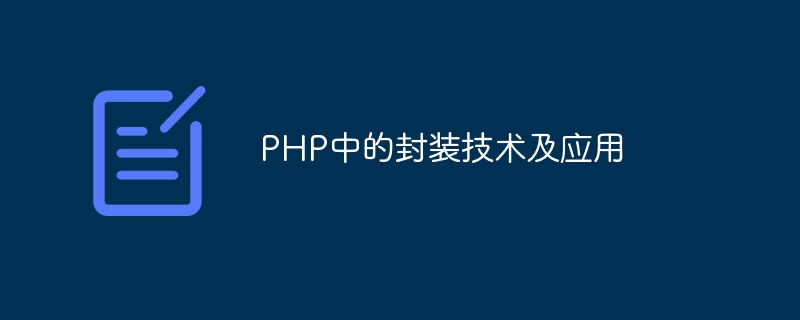

Encapsulation technology and application in PHP
Encapsulation is an important concept in object-oriented programming. It refers to encapsulating data and data operations together. , in order to provide a unified access interface to external programs. In PHP, encapsulation can be achieved through access control modifiers and class definitions. This article will introduce encapsulation technology in PHP and its application scenarios, and provide some specific code examples.
1. Encapsulated access control modifiers
In PHP, encapsulation is mainly achieved through access control modifiers. PHP provides three access control modifiers, namely public, protected and private.
class MyClass { public $publicProperty; public function publicMethod() { echo "This is a public method."; } } $myObject = new MyClass(); $myObject->publicProperty = "Public property value"; echo $myObject->publicProperty; // 打印输出:Public property value $myObject->publicMethod(); // 打印输出:This is a public method.
class MyClass { protected $protectedProperty; protected function protectedMethod() { echo "This is a protected method."; } } $myObject = new MyClass(); $myObject->protectedProperty = "Protected property value"; // 报错,无法直接访问protected属性 $myObject->protectedMethod(); // 报错,无法直接调用protected方法
class MyClass { private $privateProperty; private function privateMethod() { echo "This is a private method."; } } $myObject = new MyClass(); $myObject->privateProperty = "Private property value"; // 报错,无法直接访问private属性 $myObject->privateMethod(); // 报错,无法直接调用private方法
2. Encapsulation application scenarios
The application scenarios of encapsulation in PHP are very wide. The following are some common encapsulation application scenarios.
class DB { private $conn; public function __construct($host, $user, $password, $database) { $this->conn = new mysqli($host, $user, $password, $database); if ($this->conn->connect_error) { die("Connection failed: " . $this->conn->connect_error); } } public function query($sql) { return $this->conn->query($sql); } // 其他数据库操作方法... } $db = new DB("localhost", "username", "password", "database"); $result = $db->query("SELECT * FROM users"); while ($row = $result->fetch_assoc()) { echo $row["username"]; }
class APIClient { private $apiUrl; public function __construct($apiUrl) { $this->apiUrl = $apiUrl; } public function get($endpoint, $params = []) { $url = $this->apiUrl . "/" . $endpoint . "?" . http_build_query($params); return file_get_contents($url); } public function post($endpoint, $data = []) { $options = [ "http" => [ "method" => "POST", "header" => "Content-type: application/x-www-form-urlencoded", "content" => http_build_query($data) ] ]; $context = stream_context_create($options); return file_get_contents($this->apiUrl . "/" . $endpoint, false, $context); } // 其他API调用方法... } $client = new APIClient("https://api.example.com"); $response = $client->get("users", ["page" => 1, "limit" => 10]); echo $response;
class File { private $filePath; public function __construct($filePath) { $this->filePath = $filePath; } public function read() { return file_get_contents($this->filePath); } public function write($data) { file_put_contents($this->filePath, $data); } // 其他文件操作方法... } $file = new File("path/to/file.txt"); $file->write("Hello, world!"); echo $file->read();
The above are the application scenarios and specific code examples of encapsulation technology in PHP. Encapsulation can improve the maintainability and reusability of code and reduce the coupling of code. It is an important concept in object-oriented programming. I hope this article can help readers understand and apply packaging technology in PHP.
The above is the detailed content of Packaging technology and application in PHP. For more information, please follow other related articles on the PHP Chinese website!
 How to set cad point style
How to set cad point style The most prominent features of computer networks
The most prominent features of computer networks How to open jsp
How to open jsp What is the difference between TCP protocol and UDP protocol?
What is the difference between TCP protocol and UDP protocol? The difference between threads and processes
The difference between threads and processes How to change c language software to Chinese
How to change c language software to Chinese Why does vue.js report an error?
Why does vue.js report an error? How to open the terminal window in vscode
How to open the terminal window in vscode



